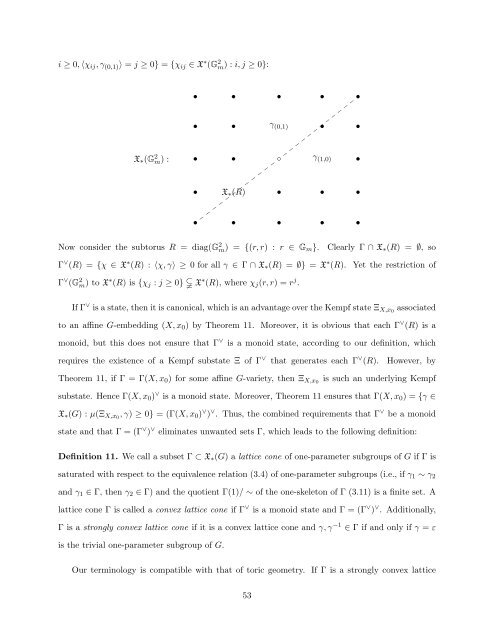Equivariant Embeddings of Algebraic Groups
Equivariant Embeddings of Algebraic Groups
Equivariant Embeddings of Algebraic Groups
Create successful ePaper yourself
Turn your PDF publications into a flip-book with our unique Google optimized e-Paper software.
i ≥ 0, 〈χ ij , γ (0,1) 〉 = j ≥ 0} = {χ ij ∈ X ∗ (G 2 m) : i, j ≥ 0}:<br />
• • • • •<br />
<br />
<br />
<br />
<br />
<br />
• • γ (0,1) <br />
• •<br />
<br />
<br />
<br />
<br />
X ∗ (G 2 <br />
m) : • • ◦<br />
γ (1,0) •<br />
• X ∗ (R) • • •<br />
• • • • •<br />
Now consider the subtorus R = diag(G 2 m) = {(r, r) : r ∈ G m }.<br />
Clearly Γ ∩ X ∗ (R) = ∅, so<br />
Γ ∨ (R) = {χ ∈ X ∗ (R) : 〈χ, γ〉 ≥ 0 for all γ ∈ Γ ∩ X ∗ (R) = ∅} = X ∗ (R). Yet the restriction <strong>of</strong><br />
Γ ∨ (G 2 m) to X ∗ (R) is {χ j : j ≥ 0} X ∗ (R), where χ j (r, r) = r j .<br />
If Γ ∨ is a state, then it is canonical, which is an advantage over the Kempf state Ξ X,x0 associated<br />
to an affine G-embedding (X, x 0 ) by Theorem 11. Moreover, it is obvious that each Γ ∨ (R) is a<br />
monoid, but this does not ensure that Γ ∨ is a monoid state, according to our definition, which<br />
requires the existence <strong>of</strong> a Kempf substate Ξ <strong>of</strong> Γ ∨ that generates each Γ ∨ (R).<br />
However, by<br />
Theorem 11, if Γ = Γ(X, x 0 ) for some affine G-variety, then Ξ X,x0<br />
is such an underlying Kempf<br />
substate. Hence Γ(X, x 0 ) ∨ is a monoid state. Moreover, Theorem 11 ensures that Γ(X, x 0 ) = {γ ∈<br />
X ∗ (G) : µ(Ξ X,x0 , γ) ≥ 0} = (Γ(X, x 0 ) ∨ ) ∨ . Thus, the combined requirements that Γ ∨ be a monoid<br />
state and that Γ = (Γ ∨ ) ∨ eliminates unwanted sets Γ, which leads to the following definition:<br />
Definition 11. We call a subset Γ ⊂ X ∗ (G) a lattice cone <strong>of</strong> one-parameter subgroups <strong>of</strong> G if Γ is<br />
saturated with respect to the equivalence relation (3.4) <strong>of</strong> one-parameter subgroups (i.e., if γ 1 ∼ γ 2<br />
and γ 1 ∈ Γ, then γ 2 ∈ Γ) and the quotient Γ(1)/ ∼ <strong>of</strong> the one-skeleton <strong>of</strong> Γ (3.11) is a finite set. A<br />
lattice cone Γ is called a convex lattice cone if Γ ∨ is a monoid state and Γ = (Γ ∨ ) ∨ . Additionally,<br />
Γ is a strongly convex lattice cone if it is a convex lattice cone and γ, γ −1 ∈ Γ if and only if γ = ε<br />
is the trivial one-parameter subgroup <strong>of</strong> G.<br />
Our terminology is compatible with that <strong>of</strong> toric geometry. If Γ is a strongly convex lattice<br />
53
















